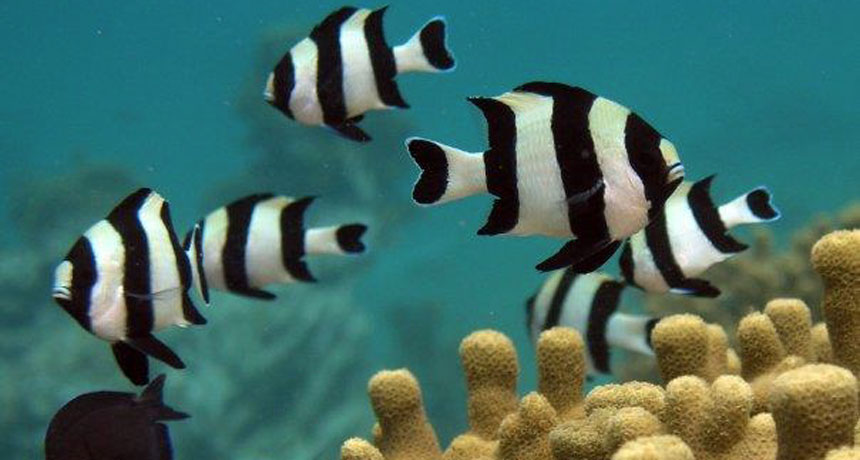Reef fish act drunk in carbon dioxide–rich ocean waters
In first test in the wild, fish lose fear of predators’ scent

SMELL NO EVIL Young damselfishes (shown) living in carbon dioxide-rich waters have trouble detecting predator odors, compared to fish in areas with less CO2 dissolved in the water.
Danielle Dixson
Carbon dioxide can really mess with fishes’ heads. Dissolved in ocean water, the acidic chemical turns timid young reef fish into tipsy little daredevils, researchers report April 13 in Nature Climate Change.
The findings are the first to show that carbon dioxide makes fish in the wild act just as crazy as fish dosed with the greenhouse gas in the lab, says marine biologist Astrid Wittmann of the Alfred Wegener Institute in Bremerhaven, Germany, who was not involved with the new work.
“These are pretty major behavioral changes,” she says. “They’re absolutely surprising.”
As carbon dioxide pours into the atmosphere, the gas filters down into oceans, slowly but steadily dialing up the waters’ acidity. In laboratory tests, fish exposed to carbon dioxide–infused waters have hearing and learning problems and odd behavior issues: They seek out predators’ odors.
Fish in the wild behave the same way, says study coauthor Danielle Dixson, a marine ecologist at the Georgia Institute of Technology in Atlanta. Damselfish and cardinal fish living in carbon dioxide–rich waters also ventured farther from home and hid out less in their coral shelters than did fish from low-gas waters, she and colleagues found.
“The fish behave kind of like they’re drunk,” she says. “They’re extra bold and extra aggressive, and they make bad decisions.”
If oceans continue soaking up carbon dioxide, by the end of this century, she adds, reef fish all over the sea may act more addled than their ancestors.
Dixson, study coauthor Philip Munday of James Cook University in Townsville, Australia and colleagues wondered if fish used to living in the CO2-rich water might acclimate to the extra acidity — just as humans can acclimate to high elevations.
So the team boated out to Milne Bay in Papua New Guinea to study fish living near carbon dioxide seeps, or bubble reefs — natural spots in the ocean where the gas leaks from the seafloor. The water in these bubbly zones holds about 1,000 parts per million carbon dioxide, or more than twice as much carbon dioxide as the water in nearby reefs without seeps. That level matches the average amount of CO2 scientists predict oceans will hold by 2100, Dixson says.
The researchers placed fish one by one in a shallow chamber and gently pumped in side-by-side streams of water seasoned with different smells to create two areas in the chamber with distinct scents. Fish from the bubble reefs basked in water laced with predator odor, Dixson says, while fish from less acidic waters steered clear of the scary scent.
“If fish can’t tell the difference between predators and nonpredators,” she says, “there’s a serious problem.”
Fish use odors to glean clues about potential mates, nearby danger and what’s for lunch. So a fish with a distorted sense of smell is blinded to the everyday cues of their watery worlds.
But researchers don’t think the carbon dioxide–exposed fish have anything wrong with their noses. In previous studies, the team has traced laboratory animals’ odd behaviors to problems in the brain.
“We were hoping that the fish would be able to cope with high levels of carbon dioxide,” says study coauthor Katharina Fabricius, a reef ecologist at the Australian Institute of Marine Science in Townsville. “But that was not the case. These fish are mad — they lose their ability to think straight.”






